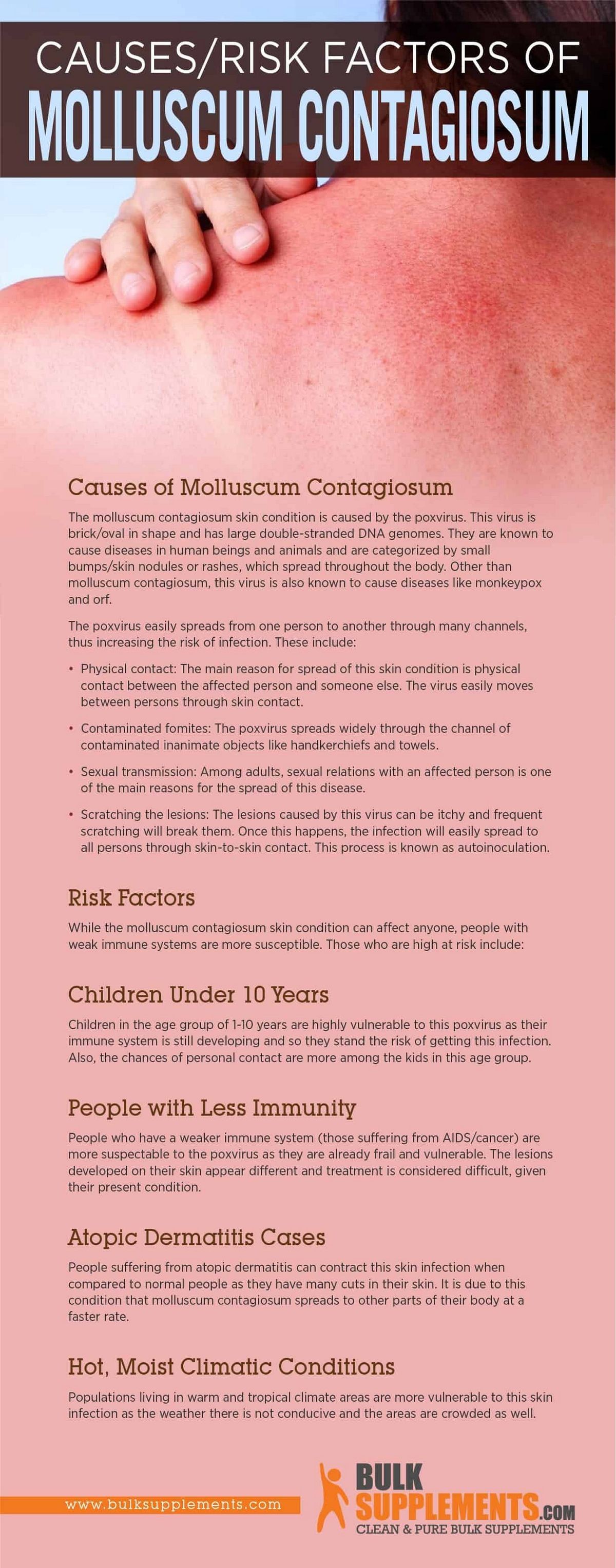
Contents
- 1 Molluscum Contagiosum
- 1.0.1 What triggers molluscum contagiosum?
- 1.0.2 What are the risk factors for molluscum contagiosum?
- 1.0.3 Is molluscum contagiosum contagious?
- 1.0.4 What is the incubation period for molluscum contagiosum?
- 1.0.5 How long does the infection with molluscum contagiosum last?
- 1.0.6 What are the symptoms of molluscum contagiosum?
- 1.0.7 What type of doctors treat molluscum contagiosum?
- 1.0.8 How do physicians diagnose molluscum contagiosum?
- 1.0.9 What are the stages of molluscum contagiosum?
- 1.0.10 What is the treatment for molluscum contagiosum?
- 1.0.11 Are there any home remedies for molluscum contagiosum?
- 1.0.12 What is the prognosis of molluscum contagiosum?
- 1.0.13 Is it possible to prevent molluscum contagiosum?
- 1.0.14 Subscribe to MedicineNet’s Skin Care & Conditions Newsletter
Molluscum Contagiosum
Molluscum contagiosum is a mild skin disease caused by a virus that results in painless small bumps or lumps. The bumps can be flesh-colored or skin-colored, dome-shaped papules, some of which may be umbilicated. This means that the lesion has a central depression resembling a navel on the skin. The disease is found worldwide but is more common in warm, humid climates.
Generally, molluscum contagiosum is not serious and resolves without treatment in 6 to 12 months. It is commonly seen in children and can be transmitted through direct person-to-person contact or contact with contaminated items like clothing or towels. While some consider it a sexually transmitted disease, many view it as a contagious skin disease that can be transmitted through any skin-to-skin contact in adults, the elderly, and children.
The virus can infect any part of the body, including the face, through self-transfer of the virus to another area of the skin.
What triggers molluscum contagiosum?
The cause of molluscum contagiosum is a virus known as molluscum contagiosum virus, which belongs to the poxvirus family. The virus only survives in the skin and is no longer contagious once the lesions have disappeared.
What are the risk factors for molluscum contagiosum?
The highest risk factor is direct contact with a skin lesion on an infected person or contact with items like towels that an infected person has recently used. People with weakened immune systems are more susceptible to the infection and may experience rapid spread with larger lesions. Other high-risk groups include wrestlers, swimmers, gymnasts, and people who use steam baths and saunas. Although theoretically possible, there is no documented evidence of contracting the virus from a toilet seat.
Is molluscum contagiosum contagious?
Molluscum contagiosum is highly contagious, spreading through direct skin-to-skin contact or indirect contact with contaminated items used in contact sports. The virus can be transferred from towels or other objects to another person’s skin.
What is the incubation period for molluscum contagiosum?
The incubation period for molluscum contagiosum is typically 2 to 7 weeks, but it can be as long as 6 months in some individuals.
How long does the infection with molluscum contagiosum last?
The skin lesions associated with molluscum contagiosum generally persist for 6 to 12 months, but in some cases, they can last up to 4 years. Once the lesions resolve, the person is no longer contagious. The contagious period varies depending on the resolution of the lesions.
What are the symptoms of molluscum contagiosum?
The initial signs and symptoms of molluscum contagiosum are small, painless papules on the skin. These raised bumps may appear as pearly pinkish or pearl-like nodules with a central dimple. Most lesions are small, about 2-5 mm in diameter. Some nodules contain a cheesy whitish core. The lesions may become itchy if scratched but are generally not painful. In some cases, the lesions may develop redness or inflammation. Molluscum contagiosum lesions can appear anywhere on the body, including the face, inner thighs, and genital area.
What type of doctors treat molluscum contagiosum?
While primary care providers and pediatricians can treat molluscum contagiosum, board-certified dermatologists, infectious disease specialists, and pathologists may provide consultations for diagnosis and treatment.
How do physicians diagnose molluscum contagiosum?
Doctors diagnose molluscum contagiosum based on the person’s history and physical examination. A definitive diagnosis is usually made by a pathologist or dermatologist through a skin biopsy or tissue scraping that shows the viral infection. This diagnosis is particularly useful in distinguishing molluscum contagiosum from other skin conditions such as herpes, genital warts, hives, atopic dermatitis, skin cancer, bacterial infections, or folliculitis.
What are the stages of molluscum contagiosum?
Molluscum contagiosum lesions may go through three stages:
- The first stage is a small whitish and/or reddish bump on the skin.
- Over a few weeks, the bumps can enlarge to about 2-5 mm with a whitish pus head that develops into a small crater when it bursts. This is stage two, and it is advised not to attempt to pop these bumps.
- Stage three occurs when the burst craters develop into reddish sores, making them susceptible to secondary infections.
What is the treatment for molluscum contagiosum?
In most cases, molluscum contagiosum does not require treatment as the lesions usually disappear spontaneously within 6 to 12 months. However, there are various treatment options available. It is important to discuss these options with a doctor.
- Treatment methods such as cryotherapy (freezing with liquid nitrogen), curettage (cutting out the lesions), and laser therapy may remove lesions.
- Certain creams, such as those containing podophyllotoxin, salicylic acid, tretinoin, or cantharidin, can also remove lesions.
- Cimetidine may be used to treat molluscum contagiosum in small children.
- A medication called imiquimod helps strengthen the skin’s immune response and may aid in the removal of lesions for some individuals.
- Topical low-dose corticosteroid cream can reduce symptoms associated with scratching the nodules.
- Some physicians may treat the disease with topical anti-inflammatory medications like diclofenac gel, although further research is needed.
Are there any home remedies for molluscum contagiosum?
While there are several home remedies available for molluscum contagiosum, there is limited data to support their effectiveness. Remedies such as apple cider vinegar, tea tree oil, alcohol, iodine, hydrogen peroxide, elderberry extract, and duct tape occlusion have been tried by some individuals. However, it is crucial to consult with a doctor before attempting any home remedy.
What is the prognosis of molluscum contagiosum?
Most people with molluscum contagiosum have an excellent prognosis as the infection is self-limiting and usually affects only the skin, resolving without treatment within 6 to 12 months. However, individuals with weakened immune systems may have a less optimistic outlook, as the disease can persist for years and become widespread on the skin. They may also experience secondary bacterial skin infections, which are the major complication of the disease. Some treatments, such as cryotherapy, curettage, laser therapy, and certain chemical treatments, may leave small scars. Even after being cured, reinfection and reappearance of the disease are possible.
Is it possible to prevent molluscum contagiosum?
The chances of contracting molluscum contagiosum can be reduced by taking preventive measures, including:
- Avoiding direct skin-to-skin contact with infected individuals.
- Avoiding contact with items recently touched by someone infected with molluscum contagiosum, such as clothing, towels, or benches used in contact sports.
- Choosing to abstain from sexual contact or using condoms, as condoms can prevent some individuals from getting the disease, although they may not provide complete protection if the infected area is not covered.
- Practicing good hygiene, such as washing clothes, cleaning surfaces, and limiting skin-to-skin contact, can reduce the chances of becoming infected.
Subscribe to MedicineNet’s Skin Care & Conditions Newsletter
By clicking "Submit," I agree to the MedicineNet Terms and Conditions and Privacy Policy. I also agree to receive emails from MedicineNet and understand that I may opt out of subscriptions at any time.
Sources: United States. Centers for Disease Control and Prevention. "Molluscum Contagiosum: Transmission."


